The Truth About The Impact Of Stocks Dividend Reinvesting
Companies / Dividends Apr 11, 2013 - 09:32 AM GMT There is a growing trend towards doing-it-yourself (DIY) portfolio management. Many individual investors have become disillusioned with professional investment management at various levels, to include mutual funds as well as custom-designed professionally-managed portfolios. Consequently, they have become motivated to take their financial futures into their own hands and manage their own portfolios.
There is a growing trend towards doing-it-yourself (DIY) portfolio management. Many individual investors have become disillusioned with professional investment management at various levels, to include mutual funds as well as custom-designed professionally-managed portfolios. Consequently, they have become motivated to take their financial futures into their own hands and manage their own portfolios.
Generally, I am in favor of this action as long as several conditions are met. First of all, the individual do-it-yourself investor (DIY) must be willing and able to commit the time, work and effort necessary to effectively manage a portfolio. They also need to have the proper tools and research at their disposal. In our Internet age, there are numerous free financial blogs and websites at the do-it-yourselfer's disposal. However, there are also many reasonably priced research subscription sites that ought to be considered as well.
But perhaps most importantly, I believe that the individual do-it-yourself investor (DIY) must have accurate and relevant information and knowledge at their disposal. Frankly, I believe that this particular requisite is challenging to get right for professional and lay investors alike. My reasoning is based on my experience that many widely-accepted "sacred cow" investing theorems and concepts are, in fact, either flawed , inadequate or plain wrong. Consequently, their erroneous conclusions and mistaken notions offered as facts could lead investors down the wrong paths.
In my experience, there are a couple of primary reasons for the deficiencies that many investment axioms often contain. First and foremost, much of what is promoted as truth is often based on numerous studies that are conducted utilizing data that is too generalized to be of value. For example, there are many studies debating broad concepts such as value versus growth, or the merits of dividend paying stocks versus non-dividend paying stocks. My problem with these studies lies in my observation that they are often comparing apples to oranges. Moreover, they often confuse correlation with causation, which is a major fallacy in logic.
Allow me to elaborate in order to make my point more clearly. A study conducted comparing dividend paying stocks versus non-dividend paying stocks could lead to very erroneous and even unreliable conclusions. For example, there are many categories, classifications and distinct differences among dividend paying stocks. Some grow very fast, some slow, some have higher yields and large payout ratios, and others lower yields and low payout ratios. Moreover, there are numerous differences and nuances between the two extremes.
To put it simply, I believe it is unfair and even possibly misleading to conduct a study that is so overly general that vague conclusions are derived and presented as fact. For example, turning to non-dividend paying stocks, some don't pay a dividend because they are not financially strong enough, while others don't pay a dividend because they are growing so fast that they need every dime of earnings and capital they can get their hands on to continue to feed their growth. Putting these two extremes in the same study cannot help but produce misleading conclusions.
When attempting to explain this, I like to reframe an old adage where I say "the Angels are in the details." In my experience, true information and knowledge that can be applied as wisdom will most always come from a more individualized detailed analysis. In other words, individual investors would be better served by understanding all the differences and nuances of various classes of dividend paying stocks over having a general notion that dividends are either good or bad.
Consequently, the goal of this article is to elaborate, by example, on the many different kinds of dividend paying stocks that are available for investors to invest in. With a deeper understanding of the differences within the broad classification -dividend paying stocks- individual investors should be empowered to make more intelligent decisions regarding whether or not a specific type of dividend paying stock fits in with their investment profile or not.
But equally as important, my goal is to squelch many of the myths associated with dividend growth investing specifically, and/or investing in dividend stocks in general. For example, there are widely held notions such as: The majority of stock returns come from dividends, or that dividend paying stocks perform better than non-dividend paying stocks. In truth, both of the foregoing statements are true and false at the same time. Because the true answer is, it depends on the individual stock, dividend paying or not. As Mark Twain so eloquently put it:
"it isn't what we don't know that gets us in trouble. It's what we do know that just ain't so."
What I believe Mark Twain was basically telling us is that if we hold falsehoods as absolute truths, we can be prone to making egregious errors. When dealing with something as important as managing your own money, you literally cannot afford to make mistakes, especially obvious ones, based on over-generalizations of the facts. Nor does it serve us to believe something that is not true.
Therefore, what follows will be several examples of different kinds of dividend paying stocks offered in order to provide deeper insight into several commonly held notions. As I examine each example, I will ask and answer important questions that I believe will provide greater investor insights into the actual importance and contribution of dividends versus capital appreciation. With each example, I will focus on how much return comes from dividends and how much comes from capital appreciation. I will also illustrate the precise benefits and effects of dividend reinvestment as it applies to different types of dividend paying stocks.
The Many Faces Of Dividend Paying Stocks
There are many dividend growth investors who are practitioners and enthusiasts of dividend reinvestment in one form or the other. Some will use automatic DRIP (dividend reinvestment programs), while others will collect dividends and reinvest them at their discretion. Personally, I think both approaches are valid, but I personally tend to follow the latter of collecting dividends and reinvesting them at my own discretion. Once again, there are advantages and disadvantages to both approaches, but I feel that both work very well. Discipline is the key to any successful dividend reinvestment program.
Regardless, and more to the theme of this article, one of my primary objectives is to provide the reader deeper insights into how much contribution to total return that dividend reinvesting makes. And secondarily, how big a part of total return should investors expect to receive from dividends versus capital appreciation. Furthermore, I will illustrate that this varies based on the growth potential of the unique individual categorization of the dividend stock being examined. Moreover, I want to illustrate how wide-ranging the differences are among the various types of dividend paying stocks.
In order to answer these important questions and illustrate these points, I will utilize F.A.S.T. Graphs™, the fundamentals analyzer software tool and its recently added reinvestment of dividends performance calculation option. But before I do, there are a few positioning statements and qualifiers that the reader should be aware of.
With each example, I utilize time periods where beginning valuation was more or less at earnings justified levels. I did this to eliminate as much bias as I possibly could. An underlying objective of this article is to illustrate that fair valuation and earnings growth will be the primary drivers and determinants of return. This applies to both capital appreciation and dividend income.
Consequently, the contribution that dividends offer will be a function of several characteristics. First of all, the relative level of the initial yield will be a major contributing factor. The higher the initial yield, the bigger the dividends' contribution will be to total return. In contrast, the lower the initial yield, the smaller will be the dividends' contribution to total return. On the other hand, the rate of change of earnings growth accomplished by each company will also be the major determinant of capital appreciation, and how fast the dividend of each respective company will grow.
NOTE: With each example I will present performance in two iterations. First, I will present performance where capital appreciation and dividends are calculated separately. In other words, with no reinvestment of dividends. In this iteration the reader will be able to precisely see exactly how much return comes from dividends and precisely how much return is generated by capital appreciation. With the second iteration I will utilize the dividend reinvestment option in order to illustrate the effects and benefits of dividend reinvestment as it applies to each classification of dividend paying stock. (For efficiency purposes, readers might want to spend more time examining the performance tables than reading the rhetoric associated with them.)
Average Yield Average Growth
My first example, Pentair Ltd (PNR), represents a company with an average dividend yield of 1.7% and an average operating earnings growth rate of 8.4%. (In each example, these facts will be found to the right of the graph in the FAST FACTS.)
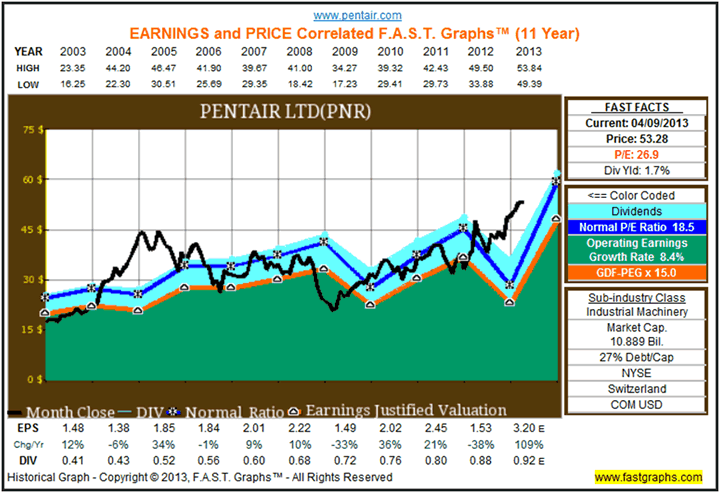
The following performance results with dividends paid but not reinvested are based on a $10,000 investment on 12/31/2002 and held to 04/09/2013. The original $10,000 investment appreciated to $30,842.19, representing a profit of $20,842.19 ($30,842.19 - $10,000 original investment = $20,842.19). This is the capital appreciation component resulting from earnings growth of 8.4% enhanced by ending overvaluation.
From the dividends paid column, we see that total dividends paid were $3,816.20. Consequently, it is clear that the majority of the total return of $34,658.39 came from capital appreciation ($20,842.19 profit versus $3,816.20 dividends). However, the inclusion of dividends increased the return from an annualized 11.6% to an annualized 12.9%. Furthermore, by viewing these items separately, we separately see the precise contribution from price appreciation versus from dividends paid.
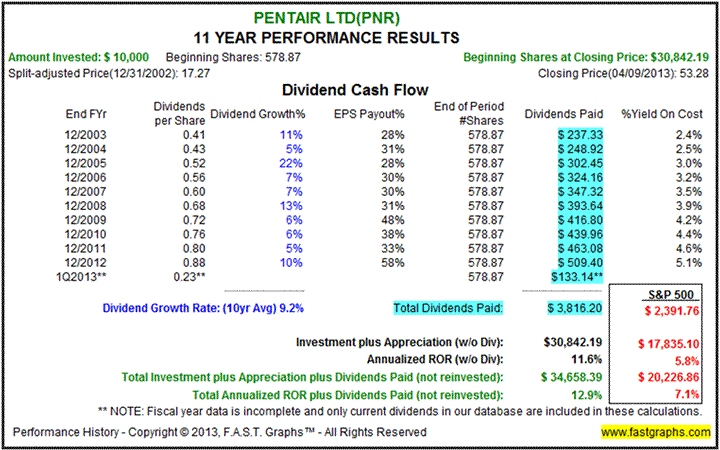
With our next performance calculation we reinvest dividends at the end of each quarter. The reader should note from the performance report above, that the first year's yield (2003) was 2.4%. Consequently, only .6%, or ¼ of the annual dividend (rate) is invested each quarter. Furthermore, it should be recognized that the annual dividend being reinvested each year, is only a fraction of the $10,000 originally invested.
As you review the following dividend reinvestment report, take note of the column marked "End of Period #Shares" where the increase in the number of shares owned at the end of each year is shown. In this example, there were approximately 12 shares purchased in 2003 versus the original beginning shares of 578.87.
By reinvesting dividends available from this average yield average growth example, the total annualized rate of return increased from 12.9% per annum to 13.7% per annum. Note that at the top right of the performance report, that the capital appreciation on the original shares at the closing price on 04/09/2013 of $30,842.19 are retained for comparison sake versus the $37,473.88 total investment, plus appreciation (with reinvestment of dividends).
I also suggest spending some time examining the performance results for other important dividend metrics. Under the Dividend Growth% column, the company's average dividend growth rate is presented. Also, the EPS Payout% (the payout ratio) is also displayed, as well as %Yield On Cost.
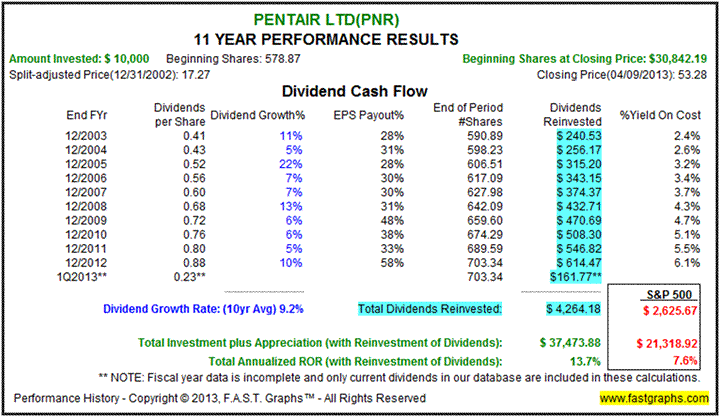
High Yield Moderate Growth
Omega Healthcare Investors (OHI) is a healthcare REIT with moderate Funds From Operations (FFO) growth of 8.3% and an above-average dividend yield of 5.6%. With this example, we will be reviewing the impact of reinvesting dividends when the dividend yield is higher than average.
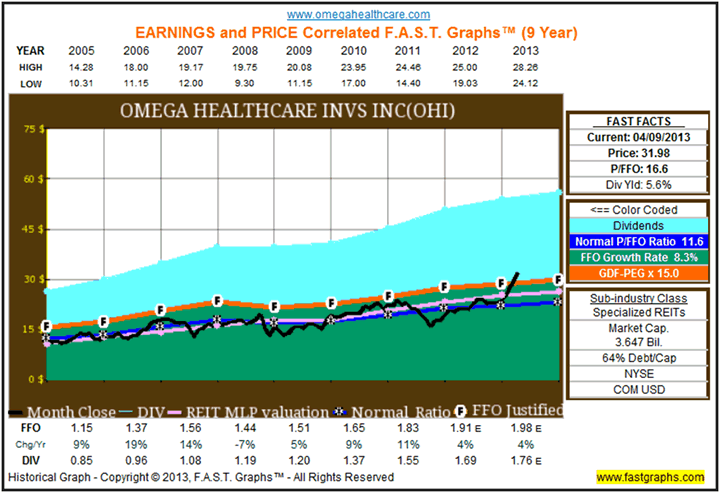
The following performance results with dividends paid but not reinvested, are based on a $10,000 investment on 12/31/2004 and held to 04/09/2013. The original $10,000 investment appreciated to $27,101.77, representing a profit of $17,101.77. This is the capital appreciation component resulting from Funds From Operations (FFO) growth of 8.3% enhanced by slight ending overvaluation.
From the dividends paid column, we see that total dividends paid were $8,762.74. Consequently, it is clear that the majority of the total return of $35,864.51 came from capital appreciation. However, the inclusion of dividends increased the return from an annualized 12.8% to an annualized 16.7%. Consequently, the higher dividend yield had a much greater impact on total annualized return than we saw with our previous average yield example. As we saw with our first example, by viewing these items separately, we see the precise contribution from price appreciation and separately from dividends paid.
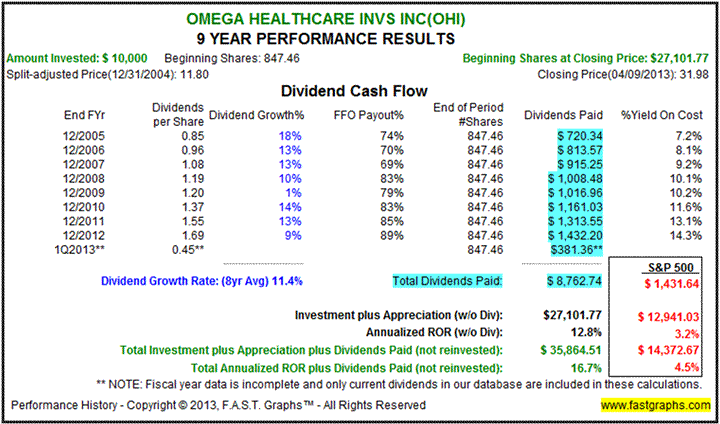
With our next performance calculation we reinvest dividends at the end of each quarter. The reader should note from the performance report above, that the first year's yield (2005) was 7.2%. Consequently, 1.8% additional capital, or ¼ of the annual dividend (rate) is invested each quarter. Furthermore, it should be recognized that the annual dividend being reinvested each year, is a larger portion relative to the original $10,000 invested than we saw with our first example.
Once again, as you review the following dividend reinvestment report, take note of the column marked "End of Period #Shares" where the increase in the number of shares owned at the end of each year is shown. In this example, there were approximately 59 shares purchased in 2005 versus the original beginning shares of 847.46, and each year additional shares are purchased and reported in this column.
By reinvesting dividends available from this high-yield moderate growth example, the total annualized rate of return increased from 16.7% per annum to 20.7% per annum. Once again, note that at the top right of the performance report, that the capital appreciation on the original shares at the closing price on 04/09/2013 of $27,101.77 are repeated for comparison sake versus the $47,371.52 total investment, plus appreciation (with reinvestment of dividends).
I also suggest spending some time examining the performance results for other important dividend metrics. Under the Dividend Growth% column, the company's average dividend growth rate is presented. Also, the EPS Payout% (the payout ratio) is also displayed, as well as %Yield On Cost, etc.
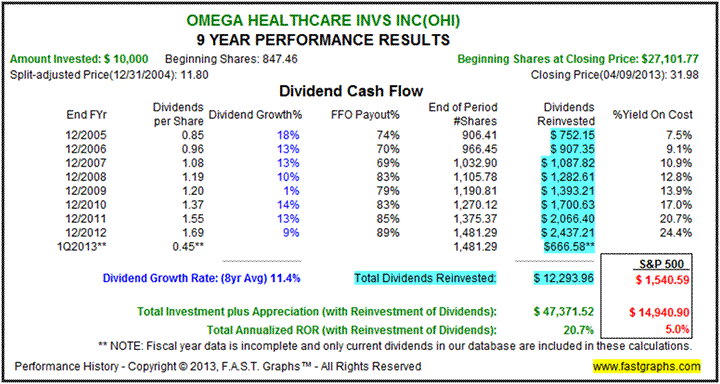
Moderate Yield Moderate Growth
Air Products & Chemicals (APD) is an example of a company with a moderate to high dividend yield of 3.3% and earnings growth of 8.4%. With this example, we will be reviewing the impact of reinvesting dividends with a moderate to high dividend yield.
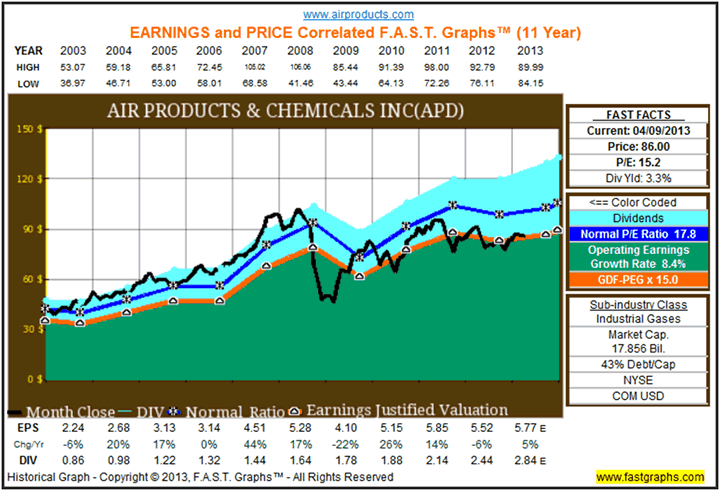
The following performance results with dividends paid but not reinvested are based on a $10,000 investment on 12/31/2002 and held to 04/09/2013. The original $10,000 investment appreciated to $20,117.12 representing a profit of $10,117.12. This is the capital appreciation component resulting from earnings growth of 8.4%.
From the dividends paid column, we see that total dividends paid were $3,922.76. Consequently, it is again clear that the majority of the total return of $20,117.12 came from capital appreciation. However, the inclusion of dividends increased the return from an annualized 7% to an annualized 8.9%. Again, by viewing these items separately, we see the precise contribution from price appreciation and separately from dividends paid.
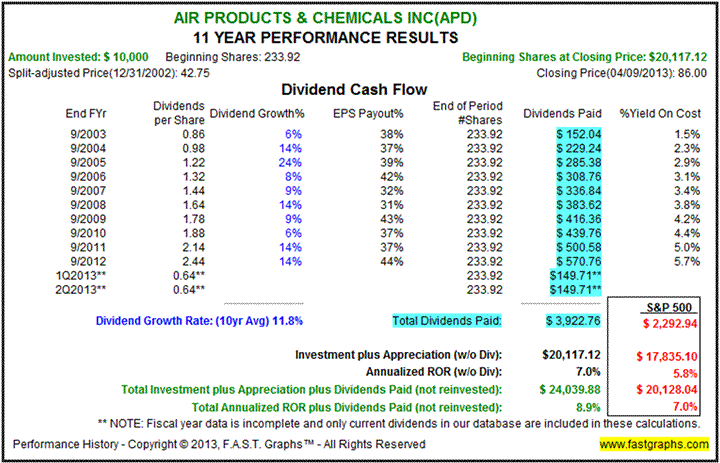
With our next performance calculation we once again reinvest dividends at the end of each quarter. The reader should note from the performance report above, that the first year's yield (2003) was 1.5%. Consequently, only .375%, or ¼ of the annual dividend (rate) is invested each quarter. Furthermore, it should be recognized that the annual dividend being reinvested each year, is only a fraction of the $10,000 originally invested.
By reinvesting dividends available from this moderate to high yield, moderate growth example, the total annualized rate of return increased from 8.9% per annum to 9.4% per annum. (Again, note that at the top right of the performance report, that the capital appreciation on the original shares at closing price on 04/09/2013 of $20,117.12 are repeated for comparison sake versus the $25,237.68 total investment, plus appreciation with reinvestment of dividends).
Again, I also suggest spending some time examining the performance results for other important dividend metrics. Under the Dividend Growth% column, the company's average dividend growth rate is presented. Also, the EPS Payout% (the payout ratio) is also displayed, as well as %Yield On Cost, etc.
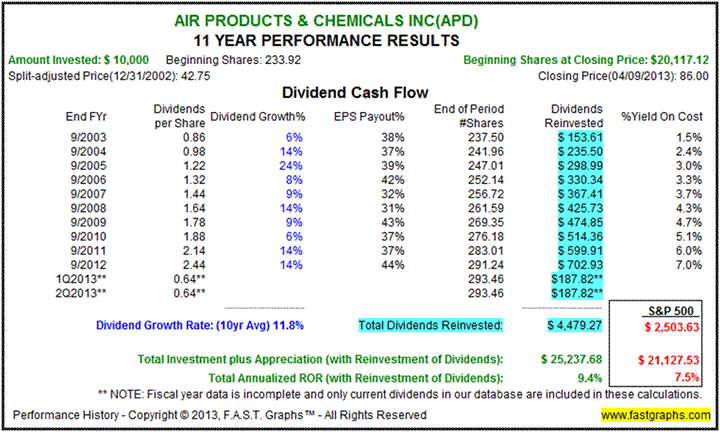
Low Yield High Growth
With my next two examples the focus turns away from dividends and on to strong operating earnings growth. Ross Stores (ROST) has a modest 1.1% dividend yield, but a 17.7% average operating earnings growth rate. Perrigo Co (PRGO) in contrast has a very modest .3% dividend yield, and a very strong operating earnings growth rate of 22.6%.
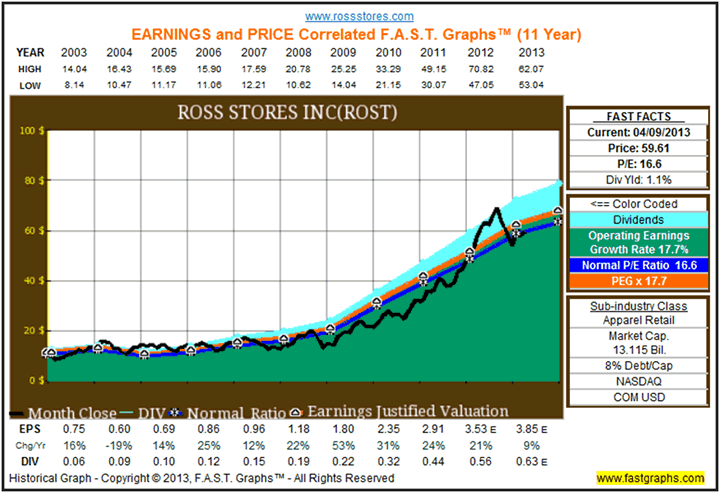
When examining Ross Stores' performance without dividends reinvested, we see a significant amount of capital appreciation, from a $10,000 original investment growing to $56,249.19 by 04/09/2013. Dividends only contribute $2,132.35. Consequently, we see the power of earnings growth as a significant generator of total return. Dividends contribute, but their impact is dwarfed by capital appreciation.
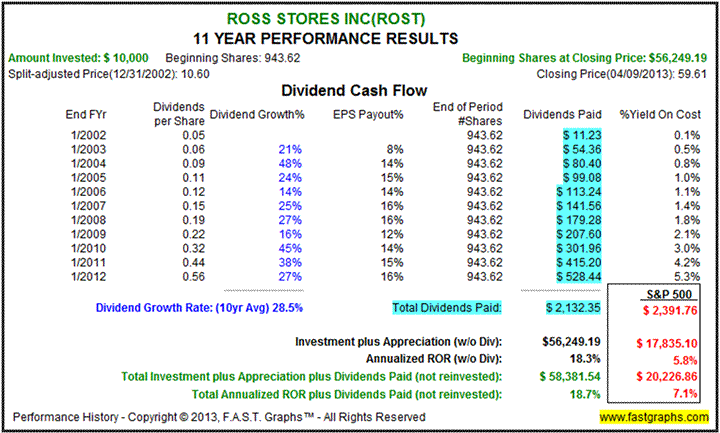
When Ross Stores' dividends are reinvested, we do see that the total investment, plus appreciation (with reinvestment of dividends) increases to $61,609.36. Consequently, total return is modestly increased from 18.7% per annum to 19.3%. This example illustrates the power of capital appreciation over dividend reinvesting when earnings growth is high and yield low.
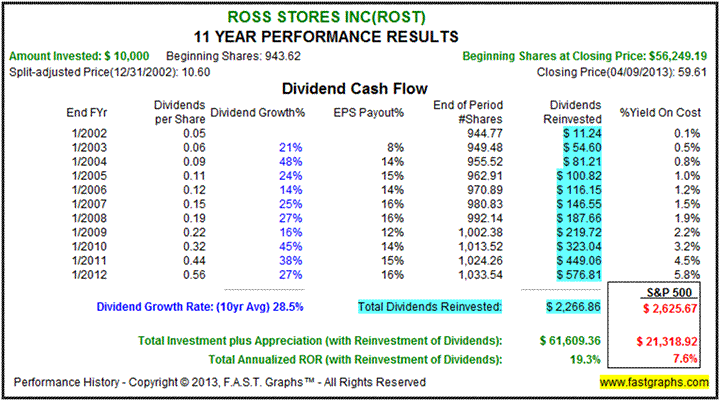
Perrigo Co in comparison to Ross Stores has a lower dividend yield of only .3% per annum, but a faster operating earnings growth rate of 22.6% per annum. Therefore, although Perrigo Co pays a dividend, as we will soon see, shareholder returns are primarily driven by earnings growth, and only modestly enhanced by dividends.
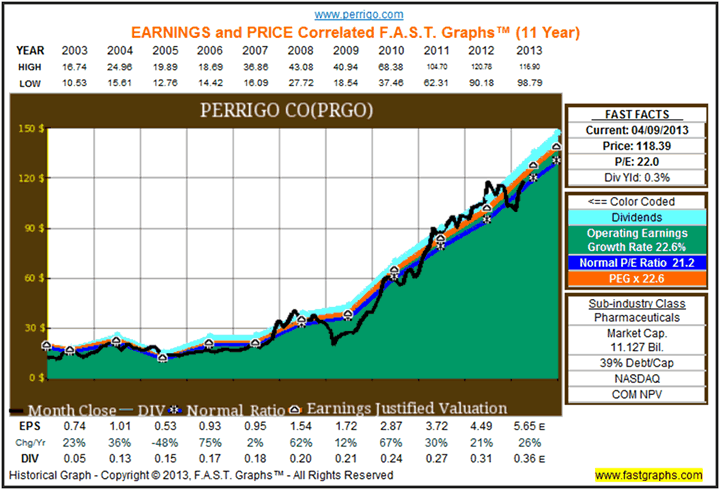
Perrigo Co turns $10,000 on 12/31/2002 into $97,440.89 by 04/09/2013. (Note, this is the highest total return of all the examples presented in this article). That is a compound annual rate of return of 24.8%, which is very consistent with its operating earnings growth rate of 22.6%. Because dividends grew in high correlation to earnings growth, Perrigo Co did distribute $1,716.05 through dividends paid. However, this clearly is dwarfed by the enormous capital appreciation of its shares.
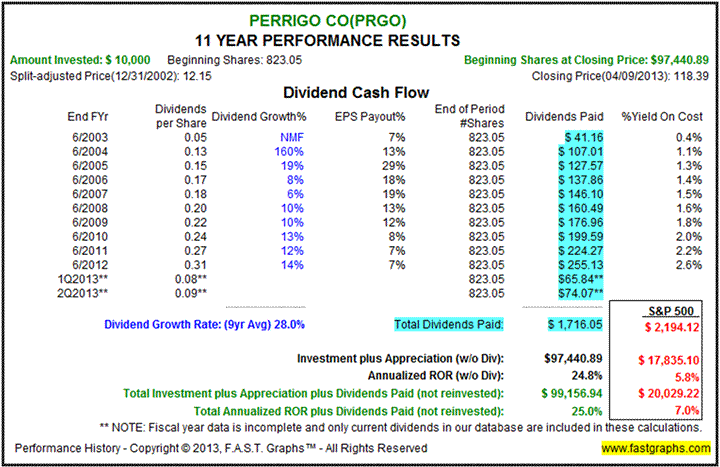
When Perrigo Co's dividends are reinvested, the total rate of return increases from 25% per annum to 25.6%. Although dividends do enhance returns, it is modest in comparison to capital appreciation available from such high growth.
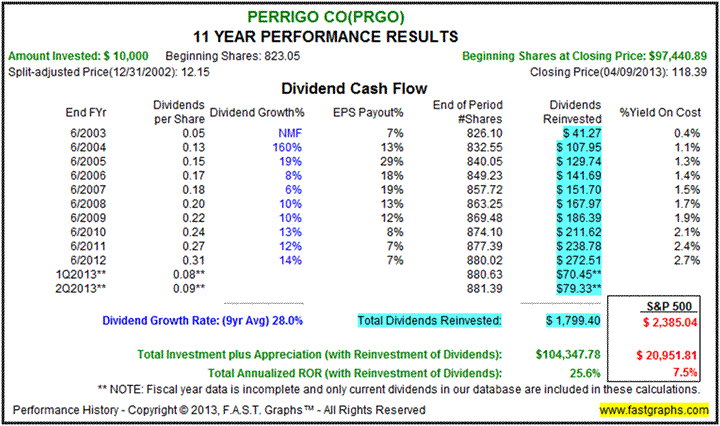
High Yield Low Growth
Consolidated Edison Inc (ED) is an example of a classic utility with a high yield and low growth. In this example, we will discover that dividends make a much larger contribution to total return.
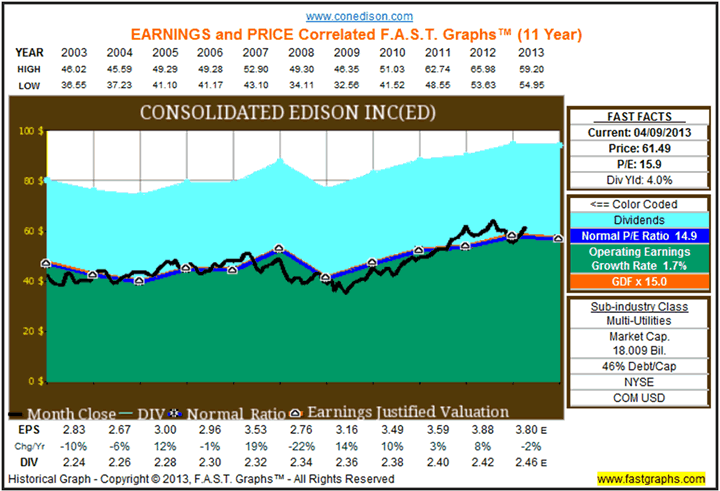
When dividends and capital appreciation are viewed separately, we discover that Consolidated Edison Co turned $10,000 originally invested on 12/31/2002 into $14,360.37 on 04/09/2013 for a total profit of $4,360.37. However, and in contrast to our previous examples, we discover that total dividends paid equal $5,441.48, or approximately $1,081 more than shareholders received form capital appreciation.
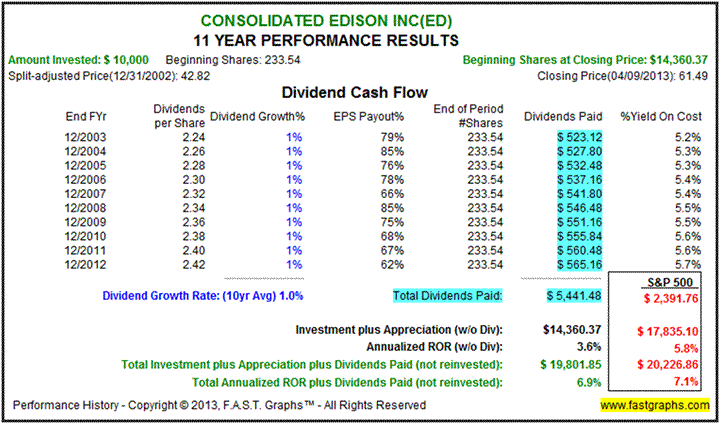
Consequently, the impact of dividend reinvesting in this example has a material effect on total return, increasing it from 6.9% per annum without reinvesting, to 8.8% when dividends are reinvested. Here we see that dividends are increasingly more important when growth is low and yield is high.
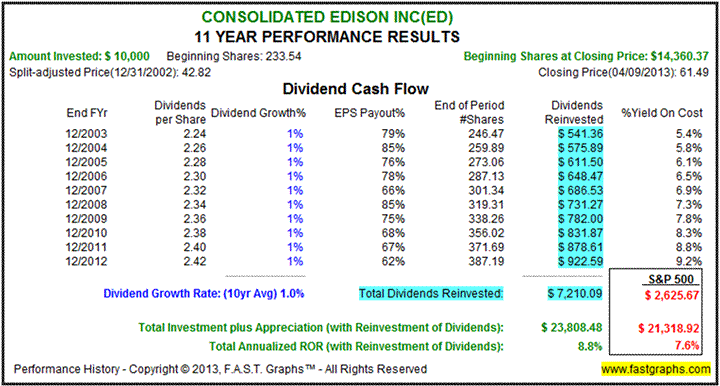
Very High Yield Low Growth
Annaly Capital Management (NLY) is a high-yielding mortgage REIT that has shown negative growth in Funds From Operations (FFO) since 2003. However, it currently offers investors a dividend yield of 11.3%. On the other hand, prospective investors should be aware that Annaly has cut their dividend no less than six times since 2003. Nevertheless, and as we will soon see, this high-yielding mortgage REIT has generated a significant amount of total dividends paid since 2003.
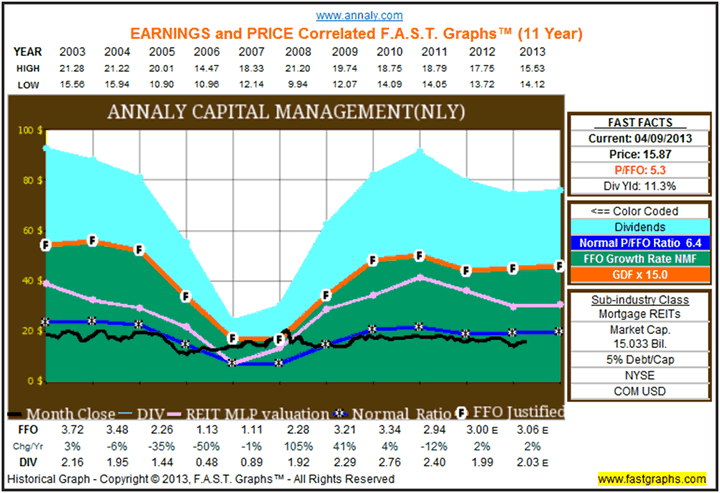
When the returns from capital appreciation (depreciation) versus dividends are viewed on Annaly Capital Management, we discover that it's all about the dividend. An original $10,000 investment on 12/31/2002 would have depreciated to only $8,441.41 by 04/09/2013. This represents a $1,558 loss of captial. In contrast, Annaly Capital Management threw off $9,936.07 of total dividends paid, bringing the total annualized rate of return from the combination of capital loss, plus dividends, to $18,377.48, for a 6.1% compounded annual rate of return.
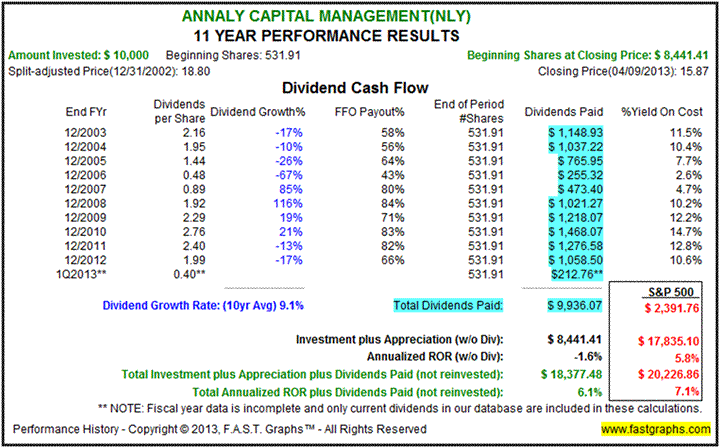
When dividends are reinvested in Annaly Capital Management, we discover that this high-yielding security purchases a significant number of additional shares, each offering a high yield. Therefore, the reinvesting of dividends with this high yield example turned $10,000 originally invested into $25,109.16, for a compounded annualized return of 9.4% per annum. On the other hand, the numerous dividend cuts could have been very troubling to shareholders depending on the income to live on, even though the yield was generally high.
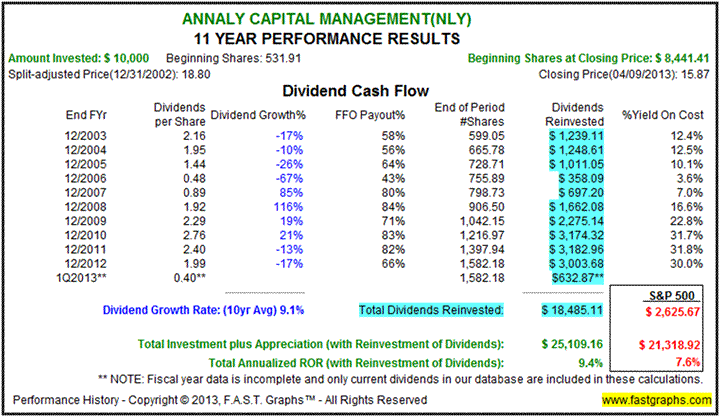
Above-Average Yield Above-Average Growth
VF Corporation (VFC) represents an example of a dividend paying stock with an above-average current yield coupled with above-average earnings growth. As we will soon see, this represents an example of a company that simultaneously offers above-average total dividends and significant capital appreciation.
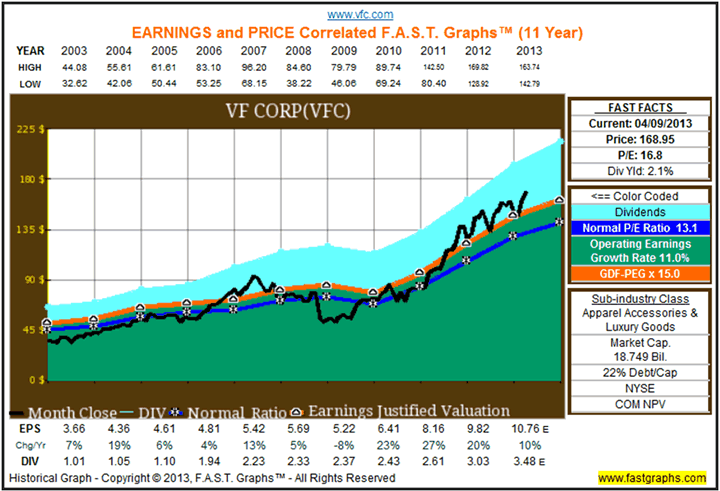
When viewed separately, we see that VF Corporation generated $5,575.54 in total dividends paid since 12/31/2002. This is significantly more than the average of $2,391.76 that investors in the S&P 500 would have earned. But, since this company generated both above-average yield and above-average growth, capital appreciation was also significant. A $10,000 investment in VF Corporation on 12/31/2002 would have grown to $46,865.04 by 04/09/2013.
Add in the $5,575.54 of dividends, and the total investment plus appreciation, plus dividends paid (not reinvested) equals $52,440.58 for a compounded return of 17.5% per annum. Consequently, strong earnings power, plus a generous dividend, rewarded shareholders at above-average levels. However, I once again focus the reader on the fact that the majority of return came from capital appreciation.
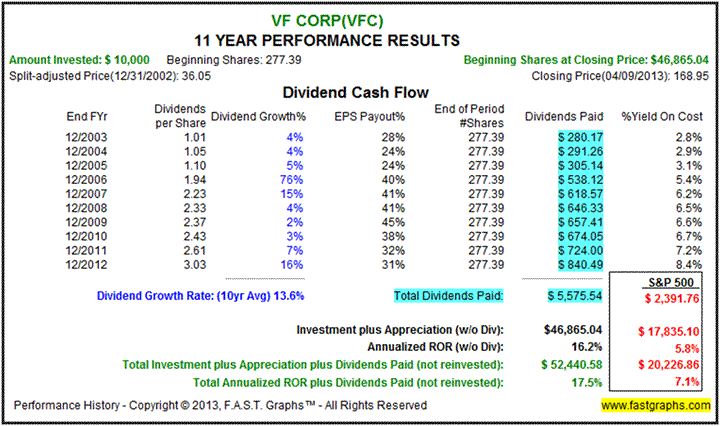
On the other hand, the benefits of reinvesting the generous and rapidly growing dividend (13.6% 10yr. average dividend growth rate) are clearly apparent. With dividends reinvested, capital appreciation, plus dividends reinvested, equals $61,183.20 for a compounded annual rate of return of 19.3% per annum
Cyclical Growth Moderate Yield
This next example, American Greetings (AM), represents a very cyclical company with virtually no growth (.2% per annum) since 2003. However, the company did institute a dividend in 2004, and its impact is significant for a cyclical no-growth company like American Greetings.
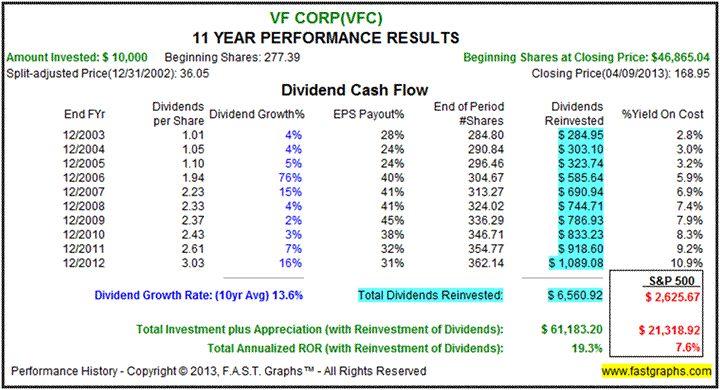
Since 12/31/2002 a $10,000 investment in American Greetings would have grown to $11,550.61. That represents a profit of $1,550.61, which turns out to be less than the $2,455.70 of total dividends the company paid. Consequently, the major contributor to total return in this example is clearly the dividend income. This also represents a case where dividends greatly reduce the risk of owning this cyclical.
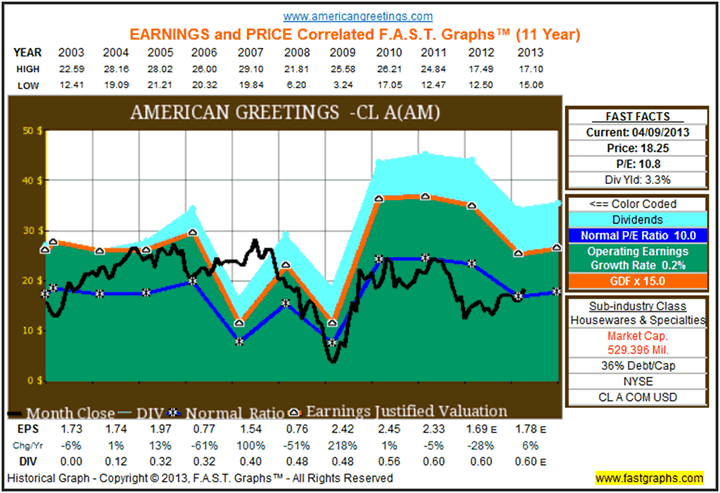
When American Greetings' dividends are reinvested, a $10,000 investment turns into $14,685.28 from the combination of capital appreciation and dividend income. However, in this case, it's the dividend that is primarily responsible for providing shareholders the modest 3.8% annualized total return.
High Yield Falling Earnings
In the spirit of balance, and in order to point out that dividend investing can be a bad idea under certain circumstances, my last example looks at Pitney Bowes Inc (PBI). Since calendar year 2008, Pitney Bowes' earnings have been in a steady decline and their stock price has followed suit. In spite of this, the company was able to maintain very modest dividend growth. But as we will soon see, dividends did not protect shareholders frm losses.
Because earnings and price have both fallen so precipitously since 2008, a $10,000 investment in Pitney Bowes on 12/31/2002 would have depreciated to $4,577.39. This represents a compound annual loss averaging -7.3%. However, even though the company did manage to pay $4,145.68, shareholders still saw their original $10,000 investment worth only $8,723.07. This worked out to an annualized loss equaling -1.3%, including dividends
Now, here is the important lesson that the Pitney Bowes' example offers. Since the stock price was in a free-fall since 2008, any dividends reinvested were buying a continuously depreciating share value. Consequently, even with a generous dividend payout, reinvesting your dividends in Pitney Bowes actually increased your annualized loss from -1.3% per annum without reinvesting dividends to -2.8% with dividends reinvested. In other words, reinvesting of dividends in a depreciating asset expanded losses and generated a worse return as a result
Summary and Conclusions
In closing, I want to be very clear that I am very much in favor of investing in dividend paying stocks. Moreover, I am also very much in favor of reinvesting dividends if the long-term accumulation of wealth at reasonable levels of risk is your objective. Therefore, nothing that was written in this article should be considered a criticism of dividend growth investing or dividend paying stocks. Instead, I would hope that this article is accepted as the opportunity to gain deeper insights into the many facets that dividend investing offers.
My motivation was to dispel widely accepted myths such as the majority of return comes from the dividends. In truth, that actually depends on the individual company. With some dividend paying stocks, and perhaps even with most dividend paying stocks, the majority of return will come from capital appreciation, even when dividends are reinvested. However, it should also be understood that beginning valuation will also have a major effect on return. Moreover, the beginning valuation (valuation at time of purchase) will have a greater effect than ending valuation due to the forces of compounding.
Dividends clearly make a significant contribution to total return. However, the growth of the business is without a doubt the most important factor, again, as long as the principles of fair valuation are adhered to. Likewise, the reinvestment of dividends will almost always increase the annual rate of return that shareholders will receive. On the other hand, the impact of dividend reinvestment may not be as great as many believe. Nevertheless, it is a powerful and safe way for investors favoring dividends to get better returns.
Finally, there are many additional benefits to dividends that this article did not specifically address. For example, it should be understood that the shareholder is, in effect, getting a return of the original capital investment every time they receive a dividend. Therefore, it can be logically concluded that with each dividend they received they have less capital at risk in the stock. Similarly, each time they reinvest dividends they increase their capital at risk in the stock. Dividend reinvestment applies to the accumulation phase of portfolio management. Once an investor is retired, the harvesting of dividends comes into play. All the dividends reinvested over the years, will thus have contributed to the amount of income the portfolio produces during the distribution phase.
Disclosure: Long OHI, ROST at the time of writing.
By Chuck Carnevale
Charles (Chuck) C. Carnevale is the creator of F.A.S.T. Graphs™. Chuck is also co-founder of an investment management firm. He has been working in the securities industry since 1970: he has been a partner with a private NYSE member firm, the President of a NASD firm, Vice President and Regional Marketing Director for a major AMEX listed company, and an Associate Vice President and Investment Consulting Services Coordinator for a major NYSE member firm.
Prior to forming his own investment firm, he was a partner in a 30-year-old established registered investment advisory in Tampa, Florida. Chuck holds a Bachelor of Science in Economics and Finance from the University of Tampa. Chuck is a sought-after public speaker who is very passionate about spreading the critical message of prudence in money management. Chuck is a Veteran of the Vietnam War and was awarded both the Bronze Star and the Vietnam Honor Medal.
© 2013 Copyright Charles (Chuck) C. Carnevale - All Rights Reserved Disclaimer: The above is a matter of opinion provided for general information purposes only and is not intended as investment advice. Information and analysis above are derived from sources and utilising methods believed to be reliable, but we cannot accept responsibility for any losses you may incur as a result of this analysis. Individuals should consult with their personal financial advisors.
Chuck Carnevale Archive |
© 2005-2022 http://www.MarketOracle.co.uk - The Market Oracle is a FREE Daily Financial Markets Analysis & Forecasting online publication.



